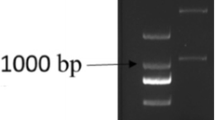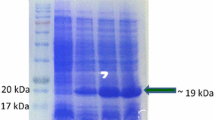Abstract
Polyclonal and monoclonal antibodies (PCAs and MCAs) were tested for the detection ofXanthomonas campestris pv.campestris (Xcc) in cabbage seeds using immunofluorescence microscopy (IF). It was concluded that PCA 94, MCAs 20H6, 2F4, 18G12 and a mixture of MCAs 20H6, 18G12, 2F4 and 16B5 could be used to detect Xcc in seed extracts when 5 min and 2.5 h shaking of seeds are used as extraction methods. The reliability of confirming suspect colonies with MCAs and PCA 94 in IF depended in part on the seed lot tested and the antibody used. Some virulent Xcc strains derived from seed lots, did not react with MCAs 10C5, 2F4, 18G12, 17C12 and 16B5. On the other hand, saprophytic isolates obtained from one seed lot cross-reacted with MCA 17C12 and to a lesser extent with MCAs 2F4, 18G12 and PCA 94. No relationship was found between IF-reactions of Xcc strains using MCAs and reactions of Xcc strains in pathogenicity testing. Xcc andX. c. pv.amoraciae (Xca) could in general not be distinguished on the basis of reactions with MCAs and PCAs. Also in pathogenicity tests Xcc and Xca were hard to distinguish.
Similar content being viewed by others
References
Alvarez, A.M. & Lou, K., 1985. Rapid identification ofXanthomonas campestris pv.campestris by ELISA. Plant Disease 69: 1082–1086
Cadmus, M.C., Rogovin, S.P., Burton, K.A., Pittsley, J.E., Knutson, C.A. & Jeanes, A., 1976. Colonial variation inXanthomonas campestris NRRL B-1459 and characterization of the polysaccharide from a variant strain. Canadian Journal of Microbiology 22: 942–948.
Franken, A.A.J.M., 1990. Production, characterization and application of monoclonal antibodies for detectingXanthomonas campestris pv.campestris in cabbage seeds. In: A. Schots (Ed.), Proceedings of the symposium Perspectives for monoclonal antibodies in agriculture, p. 27–36, PUDOC, Wageningen, the Netherlands.
Franken, A.A.J.M. & Van Vuurde, J.W.L., 1990. Problems and new approaches in the use of serology for seed-borne bacteria. Seed Science and Technology 18: 415–426.
Franken, A.A.J.M., Zilverentant J.F., Boonekamp, P.M. & Schots, A., 1992. Specificity of polyclonal and monoclonal antibodies for the identification ofXanthomonas campestris pv.campestris. Netherlands Journal of Plant Pathology 98: 81–94.
Franken, A.A.J.M., Van Zeijl, C., Van Bilsen, J.G.P.M., Neuvel, A., De Vogel, R., Van Wingerden, Y., Birnbaum, Y.E., Van Hateren, J. & Van der Zouwen, P.S., 1991. Evaluation of a plating assay forXanthomonas campestris pv.campestris. Seed Science and Technology 19: 215–226.
ISTA, 1985. International rules for seed testing. Seed Science and Technology 13: 520 pp.
Kamoun, S. & Kado, C.I., 1990. Phenotypic switching affecting chemotaxis, xanthan production, and virulence inXanthomonas campestris. Applied and Environmental Microbiology 56: 3855–3860.
Kidby, D., Sandford, P., Herman, A. & Cadmus, M., 1977. Maintenance procedures for the curtailment of genetic instability:Xanthomonas campestris NRRL B-1459. Applied and Environmental Microbiology 33: 840–845.
Machmud, M. & Black, L. L., 1985. AXanthomonas leaf spot of crucifers caused byXanthomonas campestris pv.amoraciae. Contributions of the Central Research Institute for Food Crops, Bogor 74: 1–13.
Randhawa, P.S. & Schaad, N.W., 1984. Selective isolation ofXanthomonas campestris pv.campestris from cruoifer seeds. Phytopathology 74: 268–272.
Richardson, M.J., 1990. An annotated list of seed-borne diseases (fourth edition), ISTA Handbook on seed health testing, Section 1.1. International Seed Testing Association, Zürich, Switzerland.
Schaad, N.W., 1978. Use of direct and indirect immunofluorescence tests for identification ofXanthomonas campestris pv.campestris. Phytopathology 68: 249–252.
Schaad, N.W., 1982.Xanthomonas campestris. Working sheet no. 50, ISTA Handbook on seed health testing, Section 2, International Seed Testing Association, Zürich, Switzerland.
Schaad, N.W., 1988. Laboratory guide for identification of plant pathogenic bacteria, p. 3. The American Phytopathological Society, St. Paul, Minnesota, USA.
Schaad, N.W. & Donaldson, R.C., 1980. Comparison of two methods for detection ofXanthomonas campestris in infected crucifer seeds. Seed Science and Technology 8: 383–391.
Singleton, P. & Sainsbury, S., 1987. Dictionary of microbiology and molecular biology (second edition), John Wiley & Sons, Chichester.
Taylor, J.D., Dudley, C.L. & Presly, L., 1979. Studies of halo-blight seed infection and disease transmission in dwarf beans. Annals of Applied Biology 93: 267–277.
Van Vuurde, J.W.L., Van den Bovenkamp, G.W. & Birnbaum, Y.E., 1983. Immunofluorescence microscopy and enzyme-linked immunosorbent assay as potential routine tests for the detection ofPseudomonas syringae pv.phaseolicola andXanthomonas campestris pv.phaseoli in bean seed. Seed Science and Technology 11: 547–559.
Yuen, G.Y., Alvarez, A.M., Benedict, A.A. & Trotter, K.J., 1987. Use of monoclonal antibodies to monitor the dissemination ofXanthomonas campestris pv.campestris. Phytopathology 77: 366–370.
Author information
Authors and Affiliations
Rights and permissions
About this article
Cite this article
Franken, A.A.J.M. Application of polyclonal and monoclonal antibodies for the detection of Xanthomonas campestris pv. campestris in crucifer seeds using immunofluorescence microscopy. Netherlands Journal of Plant Pathology 98, 95–106 (1992). https://doi.org/10.1007/BF01996322
Accepted:
Issue Date:
DOI: https://doi.org/10.1007/BF01996322




